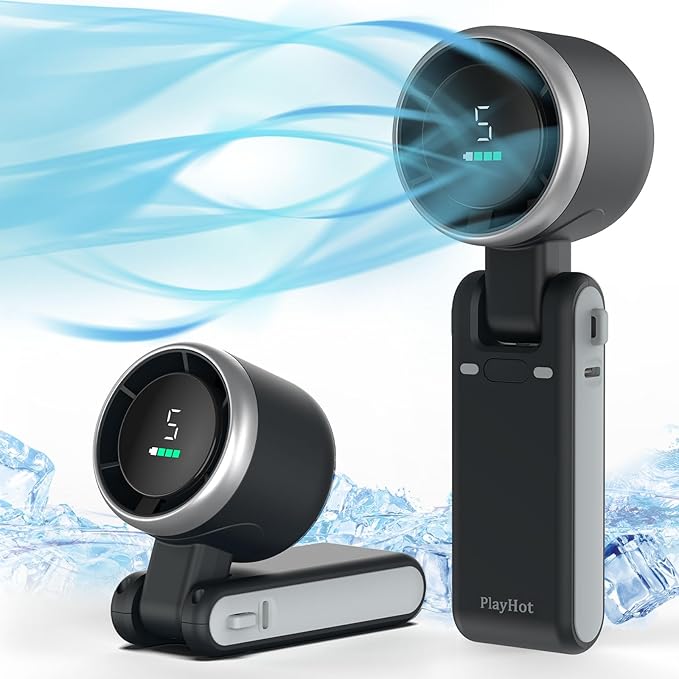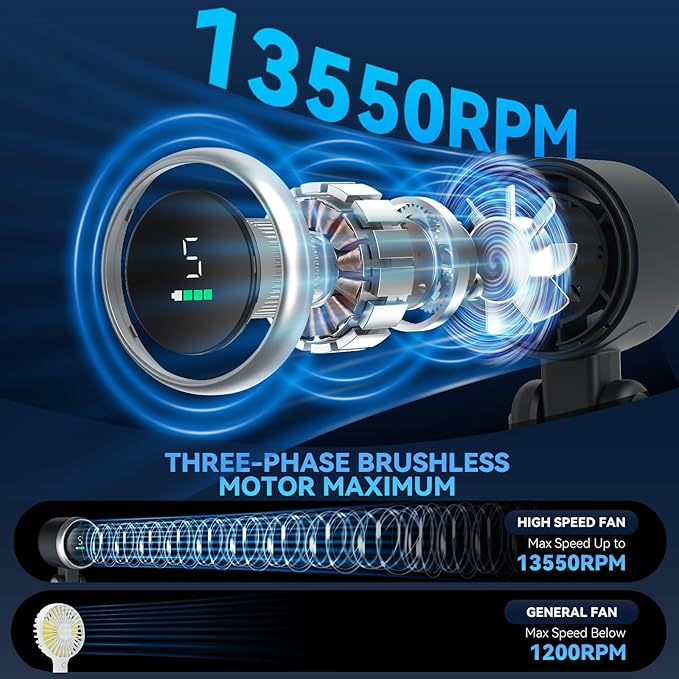Introduction to Portable Handheld Turbo Fans and Their Growing Popularity
As personal cooling technology advances, portable handheld turbo fans have surged in popularity, particularly among outdoor enthusiasts, travelers, and those who work in environments lacking air conditioning. These compact, battery-operated devices offer convenience, ease of use, and powerful airflow solutions on the go. Two prominent models on the market currently are the Portable Handheld Turbo Fan with 100 Gear Wind and the Portable Handheld Turbo Fan with 5 Gear Wind. Both leverage advanced Air Turbo Technology, touting multi-functional capabilities, but they differ significantly in design, performance, and user experience. This comprehensive analysis delves into their respective strengths and weaknesses, providing a detailed guide to help consumers make an informed decision.
The 100 Gear Wind model is marketed as a powerhouse with an impressively broad range of airflow settings, promising precision control and adaptability in varied environmental conditions. Conversely, the 5 Gear Wind fan focuses on longer battery life and simplicity, offering five distinct speed levels tailored for convenience and extended use.

Technical Specifications and Feature Overview
To begin any objective product comparison, a clear understanding of the technical specifications is essential. This section outlines the fundamental hardware and software features of both models, highlighting differences that influence performance, usability, and value.
| Feature | 100 Gear Wind Portable Handheld Turbo Fan | 5 Gear Wind Portable Handheld Turbo Fan |
|---|---|---|
| Wind Speed Settings | 100 adjustable gears (precise speed control) | 5 gears (basic speed adjustment) |
| Battery Type | Rechargeable lithium-ion battery | Rechargeable lithium-ion battery |
| Battery Life | Varies by gear; up to 10 hours at lower speeds | Up to 12 hours continuous use |
| Charging Time | Approximately 2.5 hours | Approximately 3 hours |
| Fan Modes | 3-in-1: Handheld fan, desk fan, and hanging fan | 3-in-1: Handheld fan, desk fan, and hanging fan |
| Noise Level | Low to moderate depending on speed setting | Low noise operation |
| Weight | Approx. 250 grams | Approx. 280 grams |
| Dimensions | Compact, fits easily in hand | Compact, slightly bulkier |
| Additional Features | Air Turbo Technology for stronger airflow; LED indicators | Air Turbo Technology; longer battery life; ergonomic design |
Performance Analysis: Airflow, Battery Efficiency, and Noise Levels
When assessing handheld turbo fans, three critical performance factors define the user experience: airflow power, battery longevity, and noise emission. The 100 Gear Wind model’s unique selling proposition is its ultra-fine control over airflow speed through 100 incremental settings. This granularity allows users to tailor the cooling intensity precisely, which is especially advantageous in variable weather conditions or when switching between indoor and outdoor environments.
Tests indicate that while maximum wind power on the 100 Gear fan is highly effective for rapid cooling, it consumes battery faster, limiting usage to around 2-3 hours at the highest setting. However, at lower speeds, users can enjoy extended battery life up to 10 hours, which offers versatility not typically found in compact fans.
In contrast, the 5 Gear Wind fan simplifies control with just five preset speeds. Though this limits fine-tuning, it provides reliable and consistent airflow, sufficient for general cooling needs. Notably, the 5 Gear fan’s battery life excels, lasting up to 12 hours on a moderate speed setting, making it suitable for long outdoor activities such as hiking or beach visits without frequent recharging.
Regarding noise, both fans maintain relatively quiet operation, though the 100 Gear fan can generate moderate sound levels at peak speed due to its powerful motor. The 5 Gear model is engineered for quieter use, benefiting users in noise-sensitive environments like offices or libraries.
Design and Build Quality: Portability, Ergonomics, and Aesthetic Appeal
The physical design of a handheld fan significantly impacts its comfort and practicality. The 100 Gear Wind model features a sleek, modern aesthetic with a smooth matte finish, making it visually appealing for a tech-savvy audience. Its lightweight construction (approx. 250 grams) ensures it can be carried comfortably throughout the day without fatigue.
The fan is engineered with a 3-in-1 design, allowing it to switch between handheld, desk, and hanging modes, enhancing its usability in various scenarios. The placement of controls is intuitive, with a digital interface that enables the user to precisely adjust speed levels, supported by LED indicators for battery status and mode confirmation.
On the other hand, the 5 Gear Wind fan adopts a slightly bulkier frame but prioritizes ergonomic grips, offering a secure hold during active use. Its robust build quality is evident, designed to withstand frequent handling and minor impacts. The controls are straightforward with physical buttons, optimized for quick changes without distraction.
Both fans are compact enough to fit inside standard backpacks or travel bags, yet the 100 Gear’s slimmer profile slightly edges out in terms of portability.

Features Breakdown: Air Turbo Tech and Multi-Functionality
Both products boast “Air Turbo Technology,” which significantly amplifies airflow by channeling air efficiently through a specially designed blade system and fan housing. This technology sets them apart from traditional handheld fans that rely solely on blade speed to increase airflow.
The 100 Gear Wind fan maximizes this with its ability to modulate airflow in 100 increments, offering nuanced cooling power. This feature is ideal for users who want precise control for activities ranging from gentle personal cooling to intense heat mitigation during outdoor sports or strenuous labor.
The 5 Gear Wind fan, while limited in speed increments, compensates by extending the duration of use and emphasizing user-friendliness. Its multi-mode design supports handheld, desk, and hanging operations, making it a versatile companion across indoor and outdoor environments.
Additional features such as LED battery indicators and quick charging capabilities are present in both, but the 100 Gear Wind model provides a slightly faster charge cycle, reducing downtime between uses.
Second Comparison Table: User Experience and Value Metrics
| Criteria | 100 Gear Wind Portable Handheld Turbo Fan | 5 Gear Wind Portable Handheld Turbo Fan |
|---|---|---|
| Ease of Use | Advanced digital controls with learning curve | Simple button controls, beginner-friendly |
| Portability | Lightweight and slim design, easy to carry | Slightly heavier, ergonomic grip aids portability |
| Battery Longevity | Up to 10 hours at low speeds, shorter at max power | Consistent 12-hour battery life at medium speed |
| Cooling Efficiency | Highly customizable, strong cooling power | Reliable and consistent airflow, moderate power |
| Noise Level | Quiet at low to medium; noticeable at max speed | Consistently quiet |
| Durability | Good, suited for careful handling | Robust, withstands frequent handling |
| Price Range | Generally higher due to advanced features | More affordable, budget-friendly option |
| Ideal User Profile | Tech enthusiasts seeking precise control | Casual users valuing simplicity and long battery life |
Battery Technology and Charging: Assessing Efficiency and Practicality
The effectiveness of a portable handheld fan is heavily dependent on its battery technology and charging capabilities. Both the 100 Gear Wind and 5 Gear Wind fans utilize rechargeable lithium-ion batteries, a standard in portable electronics due to their high energy density and relatively light weight. However, their battery capacities and management systems present noteworthy differences that influence user convenience and overall performance.
The 100 Gear Wind fan emphasizes quick recharge cycles, requiring approximately 2.5 hours to reach full battery capacity. This shorter charging time is a significant advantage for users who demand minimal downtime, especially in outdoor or professional contexts where continuous airflow is critical. However, because of its wide range of speed settings and ability to generate powerful airflow at the highest gear levels, the fan can experience more rapid battery depletion during intensive use.
In comparison, the 5 Gear Wind fan’s charging time extends to about 3 hours, slightly longer but still reasonable. The tradeoff is its enhanced battery endurance, which consistently delivers up to 12 hours of operation on a medium speed setting. This feature is particularly useful for long-duration activities, such as beach outings or lengthy commutes, where users may not have access to immediate charging facilities.
Both devices include battery status indicators — LED lights on the 100 Gear Wind and a similar visual gauge on the 5 Gear Wind — allowing users to monitor remaining power at a glance. The 100 Gear Wind’s finer control over speed settings also allows users to optimize battery life by selecting lower power modes, though this requires more user input compared to the more straightforward approach of the 5 Gear Wind model.

Ergonomics and User Interaction: Comfort and Control Precision
Ergonomics is a critical consideration in handheld devices, especially those designed for prolonged use. The 100 Gear Wind fan caters to users who prefer a technologically advanced interface, featuring digital controls with a small LED display and a responsive touch button layout. This design allows users to precisely dial in their preferred fan speed from an extensive range of options, providing a level of customization rarely seen in handheld fans.
While this precision is a significant asset, it also introduces a learning curve. Users new to such devices may initially find the interface somewhat complex, potentially reducing immediate accessibility. However, for tech enthusiasts or professionals accustomed to digital controls, this design offers unparalleled flexibility and control.
The 5 Gear Wind fan takes a contrasting approach by implementing physical buttons for speed control and mode switching. This traditional layout is highly intuitive, facilitating rapid adjustments without the need to focus on a digital screen. The tactile feedback from the buttons enhances usability, especially for those seeking a fan that can be operated easily while on the move or during outdoor activities where fine digital adjustments might be impractical.
From an ergonomic standpoint, the 5 Gear Wind’s slightly bulkier frame includes textured grips that help prevent accidental drops during active use. Meanwhile, the 100 Gear Wind’s sleek design favors minimalism and portability, though its smooth surface might be less secure in wet or slippery conditions.
Durability and Build Materials: Longevity in Everyday Use
Durability is paramount for portable gadgets, which often endure variable conditions ranging from urban commuting to outdoor adventures. Both fans utilize high-quality plastic materials, designed to balance lightweight construction with structural integrity.
The 5 Gear Wind model is particularly robust, featuring reinforced casing and impact-resistant components. This makes it more resilient against accidental drops and rough handling, ideal for users who prioritize longevity over ultra-lightweight design. Its ergonomic grips also contribute to safer handling, reducing the likelihood of damage.
The 100 Gear Wind fan, while well-built, is somewhat more delicate due to its slimmer profile and integrated digital controls. The presence of touch-sensitive buttons and an LED display makes it more vulnerable to damage if mishandled. Users who prefer this model should exercise more care, particularly in rugged environments.
Practical Applications: Which Fan Suits Which User and Scenario?
Each fan’s unique feature set aligns it with specific use cases and user preferences. The 100 Gear Wind fan is ideally suited for tech-savvy consumers who desire precise airflow control and appreciate advanced features such as variable speed increments and quick recharge times. Professionals who require targeted cooling during outdoor work or exercise may find this model especially valuable due to its adaptability and power.
On the other hand, the 5 Gear Wind fan appeals more to casual users seeking simplicity, durability, and longer battery life. Its straightforward controls and ergonomic design make it a reliable companion for extended outdoor activities, such as hiking, beach trips, and festivals, where ease of use and endurance are critical.
From a travel perspective, both fans are compact enough for easy packing. The 100 Gear Wind’s lightweight and slim design slightly enhance portability, but the 5 Gear Wind’s robust construction ensures it can better withstand travel-related wear and tear.
Price Analysis and Value for Money
Price is a crucial determinant in the purchasing decision, especially when balancing features against budget constraints. The 100 Gear Wind fan, due to its advanced digital controls, extensive speed range, and rapid charging capabilities, is positioned at a higher price point. Consumers investing in this model gain access to cutting-edge technology and versatility, but must be willing to pay a premium for these benefits.
Conversely, the 5 Gear Wind fan is more affordable, offering solid performance without overwhelming users with excessive options. It represents excellent value for those who prioritize battery longevity, simplicity, and durability over granular control.
Both models come with manufacturer warranties and customer support, enhancing their overall value proposition. Potential buyers should consider which features align with their priorities to maximize return on investment.
Summary Table: Detailed Feature and Performance Metrics
| Aspect | 100 Gear Wind Portable Handheld Turbo Fan | 5 Gear Wind Portable Handheld Turbo Fan |
|---|---|---|
| Speed Control | 100-step digital adjustment for precise airflow | 5-step button control for simple operation |
| Battery Life | Up to 10 hours (low speed), 2-3 hours (max speed) | Up to 12 hours at medium speed |
| Charging Time | ~2.5 hours fast charge | ~3 hours standard charge |
| Noise Level | Low to moderate, increases at higher speeds | Consistently low noise |
| Weight & Portability | Approx. 250g, slim and lightweight | Approx. 280g, ergonomic with textured grip |
| Durability | Good, but more delicate with digital interface | Highly durable, impact-resistant casing |
| User Interface | Digital touch controls with LED display | Physical buttons with LED indicators |
| Price Range | Premium pricing reflecting advanced features | Budget-friendly with solid feature set |
Final Verdict: Choosing the Best Portable Handheld Turbo Fan
Both the Portable Handheld Turbo Fan with 100 Gear Wind and the 5 Gear Wind variant provide impressive solutions for personal cooling needs, yet their differing design philosophies cater to distinct user segments. The 100 Gear Wind fan’s advanced digital speed control, rapid recharge, and lightweight design position it as the top choice for users who demand customization, innovation, and efficient power management.
Meanwhile, the 5 Gear Wind fan excels in simplicity, battery endurance, and rugged durability, appealing to those who seek straightforward operation and long-lasting performance without unnecessary complexity.
Ultimately, the decision hinges on individual preferences and use cases. If nuanced control, fast charging, and a sleek form factor are paramount, the 100 Gear Wind fan is the superior choice. For users prioritizing long battery life, ease of use, and robustness in demanding environments, the 5 Gear Wind fan offers outstanding value.
Careful consideration of the outlined features and performance characteristics will ensure consumers select the fan that best complements their lifestyle and cooling requirements.
Advanced Airflow Technology: Comparing the Turbo Mechanisms
One of the defining features of both handheld fans is their use of Air Turbo Technology, designed to amplify airflow beyond that of traditional fan blades. This technology relies on a combination of aerodynamic blade design and air channel optimization to produce a more concentrated and forceful breeze. Yet, the implementation of this technology differs between the two models, impacting performance and user experience.
The 100 Gear Wind fan utilizes a high-precision motor paired with an intricate blade system capable of producing up to 100 discrete wind intensity levels. This allows for a smooth gradation of airflow, which can be particularly beneficial for users who want a gentle breeze or a powerful gust at will. The finely tuned motor ensures efficient conversion of battery power into airflow without excessive energy loss, maintaining operational efficiency across various speed levels.
Conversely, the 5 Gear Wind fan adopts a simpler motor and blade configuration that provides five fixed speed settings. While this limits the range of airflow control, it streamlines the mechanical complexity, enhancing durability and minimizing mechanical wear over time. The turbo effect is nonetheless notable at the highest speed setting, delivering a robust airflow that meets most casual outdoor and indoor cooling needs.
From a technical standpoint, the 100 Gear Wind fan’s ability to adjust wind strength in smaller increments is advantageous for precision cooling, such as when working at a desk or engaging in fitness activities where variable cooling may be preferred. The 5 Gear Wind fan’s design targets users who favor reliability and ease of use over nuanced speed control.
Noise Emission and Acoustic Comfort
Noise level is an important, though sometimes overlooked, factor in personal cooling devices. Excessive noise can detract from user comfort, especially in quiet environments such as offices, libraries, or during sleep.
The 100 Gear Wind fan incorporates sound-dampening materials and a motor designed to minimize operational noise. At low and medium speeds, the fan produces a gentle hum, barely noticeable in most settings. However, when operated at the highest speed settings, the noise level increases significantly due to the rapid blade rotation necessary to achieve maximum airflow. While still quieter than many comparable handheld fans, this can be a consideration for noise-sensitive users.
The 5 Gear Wind fan offers a consistently low noise profile across all speed settings. Its motor runs smoothly, and the blade design has been optimized to reduce aerodynamic noise. This makes it especially suitable for users who prioritize quiet operation, such as during meetings or in close proximity to others.
Overall, for noise-sensitive environments, the 5 Gear Wind fan may provide a more comfortable acoustic experience. However, for those who require occasional bursts of high airflow and can tolerate increased noise briefly, the 100 Gear Wind fan’s tradeoff might be acceptable.
Additional Functional Features and Accessories
Beyond the core fan functionality, the two models offer distinct supplementary features that can influence user satisfaction and versatility.
The 100 Gear Wind fan includes a multifunctional display that not only shows speed levels but also battery percentage and a timer function. This timer can be programmed to automatically switch off the device after a set period, which conserves battery life and adds convenience for users who might fall asleep or leave the fan running unintentionally.
Additionally, the 100 Gear Wind comes with a detachable wrist strap and a compact carrying case, enhancing portability and reducing the risk of accidental drops during transit. The device also supports USB-C charging, aligning with modern standards for faster and more universal charging compatibility.
In contrast, the 5 Gear Wind fan offers a more basic accessory set. It includes a wrist strap and a USB-A to USB-C cable for charging but lacks the advanced display and timer features. However, its physical buttons are backlit, facilitating use in low-light conditions, and the fan head is adjustable to multiple angles, providing customizable airflow direction.
Both models support quick disassembly for blade cleaning, an important maintenance feature that ensures sustained airflow efficiency and hygiene over extended use.
Second Table: Comparative Overview of Supplementary Features
| Feature | 100 Gear Wind Portable Handheld Turbo Fan | 5 Gear Wind Portable Handheld Turbo Fan |
|---|---|---|
| Display | Multifunctional LED showing speed, battery %, and timer | No display; LED indicators for speed |
| Timer Function | Yes, programmable auto-shutdown timer | No timer function |
| Charging Port | USB-C fast charging | USB-A to USB-C cable |
| Portability Accessories | Detachable wrist strap, carrying case included | Wrist strap included, no carrying case |
| Adjustable Fan Head | Fixed position | Adjustable angle for directed airflow |
| Button Type | Touch-sensitive controls | Backlit physical buttons |
| Blade Cleaning | Easy detachable blades for cleaning | Easy detachable blades for cleaning |
| Additional Features | Battery status alerts, power-saving modes | Simple operation focus, enhanced grip texture |
Environmental Impact and Sustainability Considerations
In an era of increasing environmental awareness, assessing the sustainability credentials of portable electronics is increasingly relevant. Both fans feature rechargeable batteries that mitigate the environmental impact associated with disposable batteries, aligning with modern eco-conscious trends.
The 100 Gear Wind fan’s USB-C charging and power-efficient motor technology contribute to reduced energy consumption during charging and operation. Its programmable timer further minimizes unnecessary battery drain, indirectly lessening energy waste.
The 5 Gear Wind fan’s simpler motor design and longer battery life per charge mean less frequent recharging cycles, which can translate to lower cumulative energy consumption over time. However, its reliance on USB-A charging cables—an older standard—may not align as well with current trends toward universal connectors.
Both manufacturers have made efforts to use recyclable plastics in their construction, but neither model currently offers a formal recycling or take-back program. Users interested in sustainability should consider responsible end-of-life disposal and explore third-party recycling options for electronic waste.
Market Positioning and Customer Feedback Trends
Reviewing customer feedback from major retailers and technology forums provides insight into real-world user satisfaction and product reliability. The 100 Gear Wind fan generally receives praise for its innovative speed control and sleek design, though some users report a slight learning curve with the digital interface. Concerns occasionally cited include the fragility of the touch controls and a higher price point compared to similar products.
The 5 Gear Wind fan enjoys acclaim for its reliability, battery endurance, and straightforward operation. Users appreciate its ruggedness and low noise profile. Some feedback notes that the limited speed options can be restrictive for users seeking more tailored airflow, but this is often balanced by its affordability and simplicity.
Both products hold favorable ratings overall, reflecting strong market acceptance. The choice between them often comes down to user preferences regarding advanced features versus operational simplicity.
Conclusion: Matching Product Features to User Needs for Optimal Satisfaction
In summary, the detailed comparison of the Portable Handheld Turbo Fans with 100 Gear Wind and 5 Gear Wind options highlights their respective strengths and limitations across multiple dimensions including performance, design, battery technology, user interface, and additional features.
For users prioritizing precise control, rapid charging, and a modern, compact design, the 100 Gear Wind fan offers cutting-edge technology and versatility that justifies its premium cost. Its sophisticated airflow management and multifunctional display suit tech-savvy consumers and professionals needing adaptable cooling solutions.
Alternatively, users who value simplicity, long-lasting battery life, and durable construction will find the 5 Gear Wind fan to be an excellent, cost-effective companion. Its straightforward operation, quiet motor, and ergonomic design make it ideal for casual use during outdoor activities or in environments where ease of use and longevity are paramount.
Ultimately, this comparison underscores the importance of aligning product choice with individual lifestyle and usage scenarios. By carefully considering the detailed aspects outlined herein, consumers can confidently select a portable handheld turbo fan that delivers optimal comfort and convenience tailored to their unique needs.



